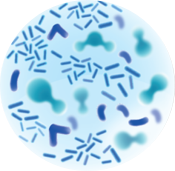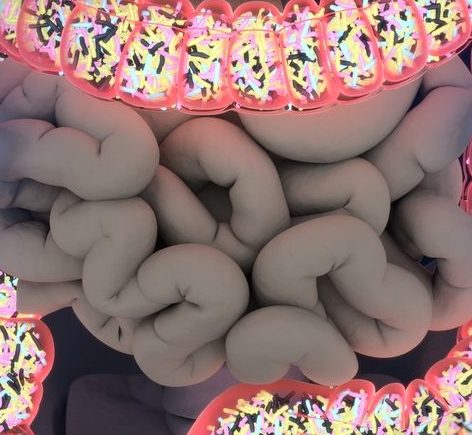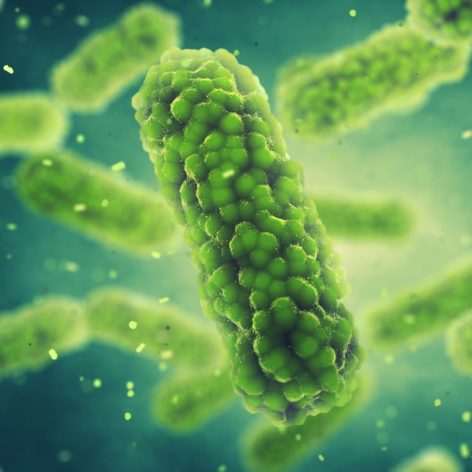Nutrition is a key factor contributing to immune fitness
Early life presents a unique window of opportunity to influence the development of the immune system, including training it to elicit the appropriate immune response to external stimuli. Nutrition is one of the most important environmental factors that can positively influence gut microbiota composition and therefore the development of a healthy immune system, which in turn improves immune fitness and optimises future health.1Lozupone CA, et al. Nature. Published on 2012; 489(7415): 220-30.
It leads to immediate benefits in terms of supporting the healthy growth and development of an individual but also over the long term by preventing and managing disease. In fact, studies show that for instance allergies may be prevented by making the right nutritional choices during the first 1000 days of life.

Human milk is the best source of nutrition for infants during the first six months of life, containing all the nutrients necessary for healthy growth and development.2WHO, Global strategy on infant and young child feeding. Published on 2003 Human milk contains numerous factors (e.g. immune cells, maternal antibodies, prebiotics, nucleotides) that work synergistically to optimise the immune system and protect the infant from infections and contribute to the prevention of allergic diseases.3Duijts L, et al. Pediatrics. Published on 2010;126:e18-25 ,4Ip S. et al. Evidence Report/Technology Assessesment. Published on 2007;153:1-186. ,5Ip S, et al. Breastfeeding Medicine. Published on 2009;4(Suppl 1):S17-S30 ,6Quigley, et al. Pediatrics. Published on 2007 119: e837-42 ,7Chantry CJ, et al. Pediatrics. Published on 2006;117:425-32 ,8Nishimura T, et al. Pediatr Int . Published on 2009;51:812-16 ,9Greer FR, et al. Pediatrics. Published on 2008;121:183-91 These factors also help reduce the risk of non-communicable diseases in later life such as inflammatory bowel disease, obesity and type-II diabetes10American Academy of Paediatrics (AAP). Pediatrics. Published on 2012;129:e827-841 For mothers who are unable to breastfeed, infant formula is a reliable alternative.
Nutritional support for the immune system in later life & during disease
Nutrition also has a therapeutic potential to manage challenges to the immune system and ameliorate certain conditions such as chronic inflammation. The potential to modulate the immune system through specific nutritional interventions is called immunonutrition, which refers to the use of an altered supply of nutrients to modify inflammatory or immune responses.
At Danone Research & Innovation, we study the effect of nutrition on immune health for people with altered nutritional needs and/or age-related changes. Specifically for disorders in the area of Tube Nutrition, Oncology, Frailty and/or Dysphagia.

Pre-, pro-, syn- & postbiotics can have a positive impact on the gut microbiota and immune system
Increasing evidence suggests that nutritional ingredients such as specific pre-, pro-, syn- and postbiotics can positively influence the immune system directly11Lehmann S, et al. PloS one. Published on 2015;10(7);pe0132304 and indirectly via modulation of the gut microbiota,12Lehmann S, et al. PloS one. Published on 2015;10(7);pe0132304 ,13Druart C, et al. Adv Nutr. Published on 2014;5(5):624S-33S ,14Wopereis H, et al. Pediatr Allergy Immunol. Published on 2014;25(5): 428-38 ,15Rachid R and Chatila TA, Curr Opin Pediatr. Published on 2016;28(6):748-53. ,16Muir AB, et al. Allergy. Published on 2016;71(9):1256-63 creating the optimal conditions for the immune system to function.17B Shouten, et al. J. Nutr. Published on 2009;139:1398–403 ,18Van der Aa, et al. Clin Exp Allergy. Published on 2010;40:795-804. ,19Chua, et al. WAC, Poster 08102015. Published on 2015 ,20Van der Aa, et al. Allergy. Published on 2011;66:170-17
Prebiotics already have been shown in multiple clinical studies to have a positive impact on the gut microbiota composition21Wopereis H, et al. Pediatr Allergy Immunol. Published on 2014;25(5): 428-38 ,22Rigo J, et al. Ciencia pediátrika. Published on 2001;21(10):390-96. ,23Moro G, et al. J Pediatr Gastro Nutr. Published on 2002;34(3):291-95. ,24Schmelzle H, et al. Published on 2003;36(3): 343-51 ,25Rinne MM, et al. FEMS Immunol Med Microbiol. Published on 2005;43(1): 59-65 ,26Haarman M and Knol J, Appl Environ Microbiol. Published on 2005;71(5):2318-24 ,27Wopereis H SK, et al. J Allergy Clin Immunol. Published on 2017 and the immune system.28Moro G, et al. Arch Dis Child. Published on 2006;91: 814-19 ,29Arslanoglu S, et al. J Nutr. Published on 2008;138(6):1091-95 ,30Scholtens PA, et al. J Nutr. Published on 2008;138(6): 1141-47 ,31Bruzzese E, et al. Dig Liv Dis. Published on 2006;38:S283-87 As an example, in high-risk infants, a six-month intervention with partial hydrolysed protein (pHP) and prebiotics reduced levels of the immune marker Cow’s Milk-specific IgG1.32Boyle R, et al. Allergy. Published on 2016;71: 701-10 Additionally, our MF6 multi-fibre blend with prebiotics has shown to have a positive influence on both gut and immune health. The MF6 blend contains 2 prebiotics FOS and inulin both known to positively stimulate the immune system directly and indirectly via modulation of the gut microbiota. Studies with the MF6 blend showed that MF6 can improve gut equilibrium by having a bifidogenic effect, increasing SCFA production, reducing feacal pH and decreases diarrhoea in patients receiving tube nutrition with the MF6 blend.
Synbiotics, a combination of pre- and probiotics, also have been shown in multiple clinical studies to have a positive impact on the gut microbiota composition and the immune system.33Abrahamse-Berkeveld M, et al. J Nutr Sci. Published on 2016;5(e42): 1-13 ,34Chatchatee P, et al. J Pediatr Gastroenterol Nutr. Published on 2014;58(4):428-37 As an example, in infants born by C-section a 12-week intervention with specific synbiotics (prebiotics + Bifidobacterium breve M-16V) was able to restore the delayed bifidobacteria colonisation35Chua MC MC, et al. Nutr. Published on 2017;65(1):102–106.
Postbiotics are bioactive compounds produced by food-grade micro-organisms during a fermentation process. There is increasing interest in postbiotics because of their wide-ranging potential benefits for human health. It is anticipated that the effects of postbiotics can be both local as well as systemic, affecting different organs and systems. For example, different postbiotic compounds have been shown to have anti-inflammatory, antimicrobial, and immunomodulatory properties36Aguilar-Toalá JE, et al. T. 2018;75:105-114. doi:10.1016/j.tifs. Published on 2018.03.009
View References
| 1 | Lozupone CA, et al. Nature. Published on 2012; 489(7415): 220-30. |
|---|---|
| 2 | WHO, Global strategy on infant and young child feeding. Published on 2003 |
| 3 | Duijts L, et al. Pediatrics. Published on 2010;126:e18-25 |
| 4 | Ip S. et al. Evidence Report/Technology Assessesment. Published on 2007;153:1-186. |
| 5 | Ip S, et al. Breastfeeding Medicine. Published on 2009;4(Suppl 1):S17-S30 |
| 6 | Quigley, et al. Pediatrics. Published on 2007 119: e837-42 |
| 7 | Chantry CJ, et al. Pediatrics. Published on 2006;117:425-32 |
| 8 | Nishimura T, et al. Pediatr Int . Published on 2009;51:812-16 |
| 9 | Greer FR, et al. Pediatrics. Published on 2008;121:183-91 |
| 10 | American Academy of Paediatrics (AAP). Pediatrics. Published on 2012;129:e827-841 |
| 11, 12 | Lehmann S, et al. PloS one. Published on 2015;10(7);pe0132304 |
| 13 | Druart C, et al. Adv Nutr. Published on 2014;5(5):624S-33S |
| 14, 21 | Wopereis H, et al. Pediatr Allergy Immunol. Published on 2014;25(5): 428-38 |
| 15 | Rachid R and Chatila TA, Curr Opin Pediatr. Published on 2016;28(6):748-53. |
| 16 | Muir AB, et al. Allergy. Published on 2016;71(9):1256-63 |
| 17 | B Shouten, et al. J. Nutr. Published on 2009;139:1398–403 |
| 18 | Van der Aa, et al. Clin Exp Allergy. Published on 2010;40:795-804. |
| 19 | Chua, et al. WAC, Poster 08102015. Published on 2015 |
| 20 | Van der Aa, et al. Allergy. Published on 2011;66:170-17 |
| 22 | Rigo J, et al. Ciencia pediátrika. Published on 2001;21(10):390-96. |
| 23 | Moro G, et al. J Pediatr Gastro Nutr. Published on 2002;34(3):291-95. |
| 24 | Schmelzle H, et al. Published on 2003;36(3): 343-51 |
| 25 | Rinne MM, et al. FEMS Immunol Med Microbiol. Published on 2005;43(1): 59-65 |
| 26 | Haarman M and Knol J, Appl Environ Microbiol. Published on 2005;71(5):2318-24 |
| 27 | Wopereis H SK, et al. J Allergy Clin Immunol. Published on 2017 |
| 28 | Moro G, et al. Arch Dis Child. Published on 2006;91: 814-19 |
| 29 | Arslanoglu S, et al. J Nutr. Published on 2008;138(6):1091-95 |
| 30 | Scholtens PA, et al. J Nutr. Published on 2008;138(6): 1141-47 |
| 31 | Bruzzese E, et al. Dig Liv Dis. Published on 2006;38:S283-87 |
| 32 | Boyle R, et al. Allergy. Published on 2016;71: 701-10 |
| 33 | Abrahamse-Berkeveld M, et al. J Nutr Sci. Published on 2016;5(e42): 1-13 |
| 34 | Chatchatee P, et al. J Pediatr Gastroenterol Nutr. Published on 2014;58(4):428-37 |
| 35 | Chua MC MC, et al. Nutr. Published on 2017;65(1):102–106. |
| 36 | Aguilar-Toalá JE, et al. T. 2018;75:105-114. doi:10.1016/j.tifs. Published on 2018.03.009 |




